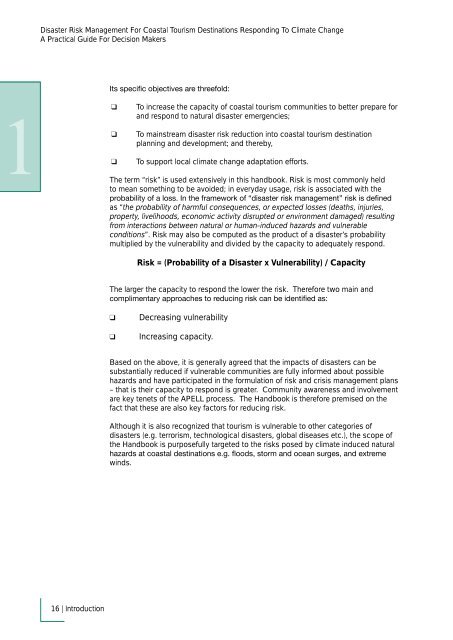Disaster Risk Management For Coastal Tourism Destinations - DTIE
Disaster Risk Management For Coastal Tourism Destinations - DTIE
Disaster Risk Management For Coastal Tourism Destinations - DTIE
You also want an ePaper? Increase the reach of your titles
YUMPU automatically turns print PDFs into web optimized ePapers that Google loves.
<strong>Disaster</strong> <strong>Risk</strong> <strong>Management</strong> <strong>For</strong> <strong>Coastal</strong> <strong>Tourism</strong> <strong>Destinations</strong> Responding To Climate Change<br />
A Practical Guide <strong>For</strong> Decision Makers<br />
<br />
<br />
<br />
<br />
To increase the capacity of coastal tourism communities to better prepare for<br />
and respond to natural disaster emergencies;<br />
To mainstream disaster risk reduction into coastal tourism destination<br />
planning and development; and thereby,<br />
To support local climate change adaptation efforts.<br />
The term “risk” is used extensively in this handbook. <strong>Risk</strong> is most commonly held<br />
to mean something to be avoided; in everyday usage, risk is associated with the<br />
<br />
as “the probability of harmful consequences, or expected losses (deaths, injuries,<br />
property, livelihoods, economic activity disrupted or environment damaged) resulting<br />
from interactions between natural or human-induced hazards and vulnerable<br />
conditions”. <strong>Risk</strong> may also be computed as the product of a disaster’s probability<br />
multiplied by the vulnerability and divided by the capacity to adequately respond.<br />
<strong>Risk</strong> = (Probability of a <strong>Disaster</strong> x Vulnerability) / Capacity<br />
The larger the capacity to respond the lower the risk. Therefore two main and<br />
<br />
<br />
<br />
Decreasing vulnerability<br />
Increasing capacity.<br />
Based on the above, it is generally agreed that the impacts of disasters can be<br />
substantially reduced if vulnerable communities are fully informed about possible<br />
hazards and have participated in the formulation of risk and crisis management plans<br />
– that is their capacity to respond is greater. Community awareness and involvement<br />
are key tenets of the APELL process. The Handbook is therefore premised on the<br />
fact that these are also key factors for reducing risk.<br />
Although it is also recognized that tourism is vulnerable to other categories of<br />
disasters (e.g. terrorism, technological disasters, global diseases etc.), the scope of<br />
the Handbook is purposefully targeted to the risks posed by climate induced natural<br />
<br />
winds.<br />
16 | Introduction

















